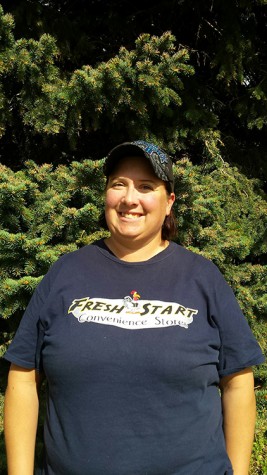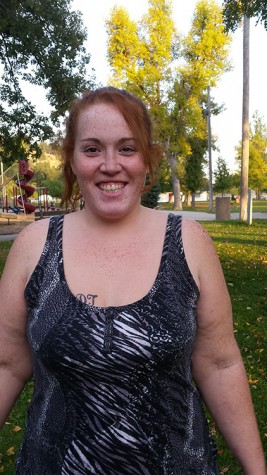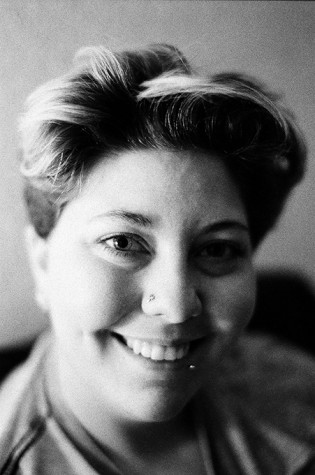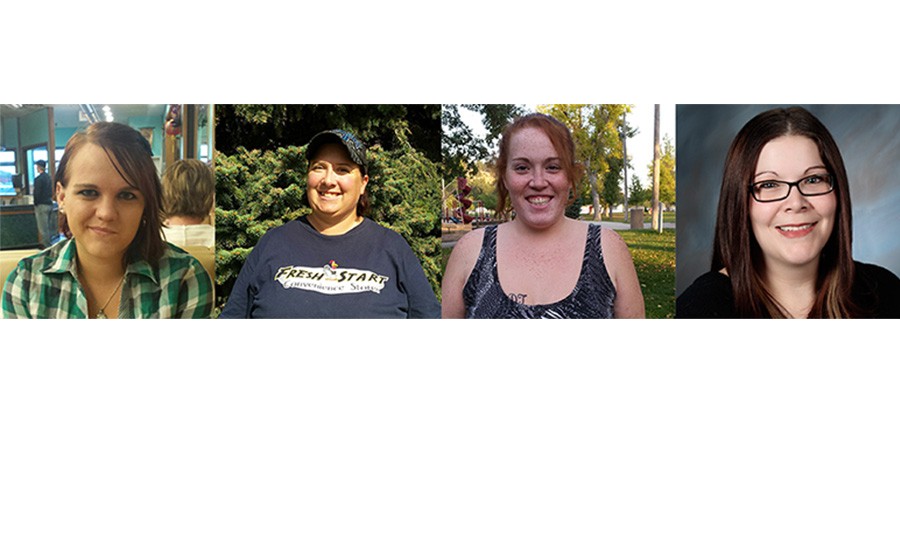Overcoming the Odds: The Faces of Invisible Illnesses

A 21-year-old Theatre Education major at Black Hills State University, Shonee Singer, sat with me to bare her soul. Singer lives with anxiety, depression and bipolar disorder.
Anxiety causes excessive worry, generally without a cause. Anxiety creates problems for Singer that people sometimes do not understand; sometimes she is too scared to leave her bed and feels the need to hide from life. One of the hardest parts of anxiety is that there generally isn’t any direct reason for it. Singer sometimes feels like she cannot talk to people because she fears being judged; though when she isn’t experiencing symptoms she is quite social. She also fears being abandoned by her friends if they knew the truth about her illness.
Not only does Singer suffer mental symptoms, she also gets the physical issues as well. Sometimes anxiety sufferers experience physical symptoms such and getting a “sinking feeling” in their stomachs and the inability to eat or keep food down. When she experiences the physical symptoms, it leads to more anxiety and fear of judgement.
Depression causes excessive sadness, generally without a cause. Though she sometimes feels a lack of motivation due to her depression, Singer tends to pull inside of herself and pretends to be okay because she doesn’t want to be a burden to anyone. She was able to discuss with me her daily struggles with thoughts of suicide and self harm. Depression causes thoughts that would not normally be in her head and she fights to think positively every day.
Bipolar disorder causes varying degrees of emotions in short periods of time. Personal relationships, Singer said, are affected by her bipolar disorder because she feels like she doesn’t have control. She has had outbursts of anger that cause tension in her relationships and she unintentionally takes out her emotions on her partners. It frightens Singer to see her emotions happen and have no control over them.
The difficulty of dealing with these invisible illnesses affects Singer daily. I asked her to explain what it is like to live with invisible illnesses and she responded with, “It’s like being trapped in my own personal hell with no escape.” Singer was happy to share her story in order to help people better understand invisible illnesses. She explained that some people don’t believe in her illnesses unless they see the effects of it. Some days are easier for her and she says that people see her good days as proof that her problems aren’t real because they don’t affect her all the time. The one thing that Singer wanted people to know was, “don’t tell people with depression or bipolar disorder to “just be happya�� because it isn’t possible.”

I exchanged emails with 36-year-old Melissa Lichtenberger who is majoring in Psychology at Black Hills State University. Lichtenberger lives with major depression, anxiety and Rheumatoid Arthritis (RA).
I asked what depression and anxiety meant to Lichtenberger and she responded with “an envelope of darkness enclosing me in a corner and even if I try to seek help, no one will care enough to open the top and let me out.” These invisible illnesses affect the ability to rationally process situations and cause Lichtenberger to constantly focus on the worst case scenario. She said that her depression and anxiety affect her family and friendships because, “I avoid everything as much as possible.”
Living with RA, in some ways, is easier than anxiety and depression because it has more physical effects. Flares are when symptoms of chronic disease are amplified for a time. Lichtenberger explained to me how flares affected her, “A flare up can render me bedridden until it passes or it can be mild enough to limit activities with my family.” Not only do flares affect her, RA saps Lichtenberger’s physical and mental energy. Rheumatoid Arthritis comes with enough problems, but the medications to help RA also come with side effects. Medications like Humira cause drowsiness and nausea as well as weakening the immune system.
When asked if people accept her invisible illnesses as real, Lichtenberger answered, “It is a battle to educate people … In the public there is such a stigma about depression, anxiety and RA that I hide myself from others by putting on a mask, figuratively.” She also told me that after she started medications to treat RA, the disease became more real to people.
Lichtenberger wants people to know that stigmas aren’t always true and these diseases are disabling physically, mentally and emotionally. She wants people to know that RA is a life sentence; it will never go away. When speaking about the invisibility of her illnesses, she said, “Just because you cannot see the disease on the outside doesn’t mean that it is not there … I am not lazy…my body just can’t do normal things.” Lichtenberger said that in the simplest terms, “Be gentle and judge not.”
I sat with a 23-year-old male who wished to remain anonymous but wanted to share his story. He was in the military but was honorably discharged due to his medical condition.
This brave man told me that he lives with Thoracic Outlet Syndrome (TOS). TOS causes the compression of nerves and blood vessels to produce inadequate passage between the base of the neck and armpit which causes symptoms. The symptoms he suffers are the loss of range of movement in his left shoulder, constant headaches, severe pain, numbness and difficulty sleeping. “I can’t reach anything on the top shelf with my left arm: shout out to you short people; I’m six feet tall and I can’t reach the top shelf,” he said.
When I asked him if people were understanding about his invisible illness he replied vehemently not, “It took me three years to get doctors to realize something was wrong.” Since he feels like nobody really believes him, he tries not to let it show but with his limited mobility, sometimes people see it. The one thing he wants people to understand is, “Just because an injury isn’t visible on the outside, doesn’t mean someone isn’t hurt.” He just wants people to keep an open mind.

One sunny day, I spoke with a previous coworker of mine, 28-year-old Jessica Whetham. Whetham lives with an invisible illness called Idiopathic Intracranial Hypertension (IIH). She explained to me that IIH is the presence of high cerebrospinal fluid in the skull which increases pressure. Whetham endures headaches, vision loss, nausea, vertigo and hearing loss. She also experiences tinnitus which is a symptom that causes buzzing, “whooshing” and other uncomfortable noises in the ear. The pressure causes Whetham’s emotions to be volatile and uncontrollable and the disease sometimes renders her immobile for short periods of time. Mentally, Whetham suffers problems with cognitive abilities and frustration due to the inability to think clearly.
There are many side effects of the medications used to treat her problems and Whetham shared that, “the medications for this disease aren’t even made for it, it’s like a band aid.” Unfortunately, Whetham said that people do not accept her illness as real. She explained,
“I can’t move my neck or head too much, I get sickening pain that I cannot explain from the back of my neck into my stomach. If I get up too quick, I have to sit down so I don’t pass out. You can get aneurysms from this. I want people to know that I’m trying my hardest every day.”
A 22-year-old Education major at Black Hills State University shared her story anonymously with me via Facebook.
This woman has an autoimmune disease that has yet to be diagnosed. She also lives with anxiety and depression. The undiagnosed autoimmune disease causes her to experience periods of time when she is unable to digest food; it can be very painful. During those periods of time, when she eats or drinks, it doesn’t stay down for very long. The woman suffers from pain in the lower left side of her abdomen that helps her recognize when these attacks are about to occur; tests have proven that her stomach stops digesting food while these attacks are happening. She said that she does not have Celiac’s disease, however she does have eosinophils and is showing signs of autoimmune disease. She described eosinophils as particles in her white blood cells.
This woman said that people do not believe her problems are real because they cannot physically see her pain. As the disease is still undiagnosed, the people around her struggle to understand it and that is only heightened by the fact that stress has a large effect on her disease. Sadly, she stated that, “I would rather work with an open, bleeding wound on my arm instead of the effects on my stomach because people wouldn’t tell me that I’m imagining anything.” When asked what she wants people to take away from her story, she explained, “Do not tell me that I’m just being a wimp when I say I am feeling sick, because you likely would “feel sicka�� if you experienced one of my good days.”
Forty-nine-year-old Outdoor Education major at Black Hills State University shared her story with me to spread awareness. The BHSU student suffers from Fibromyalgia which causes muscle inflammation that comes with pain. Along with the muscle involvement, Fibromyalgia also causes swelling and pain in the joints. The woman said that her disease can be managed with diet and exercise but there is no cure.
When asked if people accepted her illness as a real problem, she said that they mostly understand and accept her Fibromyalgia because it is a fairly new disease and there are commercials for the medications to help treat it on TV. The one thing she wanted people to understand is, “It is very painful and can be debilitating.”

Lori Erion, a 34-year-old Business Administration major at Black Hills State University shared her story via email. Erion lives with chronic pain from an injury and also experiences major depression and anxiety. The medical definition for chronic pain is pain that persists longer than 12 weeks but according to Erion, the “life definition” is very different.
Erion feels constant pain every day; the only thing that varies for her is the amount of pain she feels. She shared that some days it is a struggle to get out of bed but other times she can get up early to start her day. The “loss of a normal life” is very difficult for her and she explained how she went through the stages of grieving. Erion admitted that she feels like she is stuck in a cycle of wondering what she is missing out on and if she can make it through the day. When she talked about missing out, she revealed that she sees pain management specialists, physical therapists, psychologists and other doctors instead of being able to spend time with friends and family; “Some days the guilt, self-loathing and frustration are just too much.” She feels very frustrated by her brain fog which is caused by the pain medication she takes and since her pain triggers her anxiety, depression and stress, she has a hard time just being a student.
When I asked Erion if people accepted her illnesses as real, she responded with, “most people don’t really want to know the real answer when they ask how you are.” She admitted to hiding her diseases because she doesn’t believe people will really care. Erion knows that people either judge, sympathize or have a reaction somewhere in between. She did say that her close friends and family accepts what she lives with as real because they have seen how it has changed her. The world does not have to accept her because she stays in her own private world, she explained; “I have become the actress, and I’m damned good.”
I asked Erion if there was one thing that she wanted people to understand and her response was, “just one?” She feels like there is so much to know but she did have one thing to say: she would encourage people to be more aware and less judgemental. “We have mourned it, we have accepted it but just because we are “used to ita�� doesn’t mean it doesn’t hurt anymore and that every day is not a struggle.”
ABOUT THE AUTHOR

My name is Dustie M. Clements. I am a senior at Black Hills State University majoring in Mass Communications with an emphasis on Graphic Communication and Journalism. I suffer from Ankylosing Spondylitis (AS), Fibromyalgia, Depression and Generalized Anxiety.
Ankylosing Spondylitis is an autoimmune disease that generally attacks the spine, other large joints and soft tissues. One of the reasons it is thought to be “rarea�� is because it is very hard to diagnose; some people have pain only in their backs, others suffer only mild pain and some experience rapid spinal fusing. One of the tests to diagnose AS is testing for the gene HLA-B27, however, not all people with AS have the gene and not everyone with the gene has AS. I am HLA-B27 positive and with my AS, I have pain and swelling in all of my joints though the most pain is in my neck, back, hips and knees. My tendons and ligaments are also weakened by the disease. I am in pain every single day and, like one of the people I interviewed, the only thing that varies is the amount of pain. There is no cure for AS.
According to the official Mayo Clinic website,
“Fibromyalgia is a disorder characterized by widespread musculoskeletal pain accompanied by fatigue, sleep, memory and mood issues. Researchers believe that fibromyalgia amplifies painful sensations by affecting the way your brain processes pain signals.”
To me, Fibromyalgia is randomly feeling like someone has lit sandpaper on fire and is quickly rubbing it against my skin. No warning, no reason, just pain. There are times when my skin and muscles hurt so badly that wearing clothing is painful; wearing anything tight is absolute torture. There is no cure for Fibromyalgia, though some medications may help manage the disease.
I would be lying if I said my depression has nothing to do with my diseases; they definitely contribute, but my depression has always been a part of my life while my diseases just recently reared their ugly heads. I’ve never struggled with self harm and that is a blessing. When I think about my other health problems, I have thoughts that I will die young, never get anything worthwhile accomplished and never be happy. With the help of my family and my medications, my depression is being managed fairly well; though I have to keep fighting every day.
My generalized anxiety just adds fuel to the fire. Generalized anxiety is having anxiety about everything in general. Some people have anxiety about tests, social events or trying something new; I have anxiety about everything. I struggle to remain calm on a daily basis and I worry about small things that shouldn’t bother me.
My goal is to educate and spread awareness. When strangers see me parked in the handicapped spaces or using the electric cart at the store, I always receive glares, angry faces and negative responses; and I understand why. Strangers see a young woman with no visible problems; they cannot see my AS or my Fibromyalgia because those are invisible diseases. They do not know that after I pay for my groceries and get back to my car, I cry. I cry because I am in pain and I cry because the judgement I don’t deserve hurts me. It adds to my depression, it triggers my anxiety. On a few different occasions I have been confronted by people who think that I have stolen a handicapped car or think that I am being lazy. Each of those occasions has ended in apologies from the accuser and the spread of awareness. While these occasions end with me in tears and the accusers feeling guilty, in some ways it is good. If I can educate one person about invisible diseases, it is a successful day; but there is a better way. I shouldn’t have to defend myself against people who judge me based on my outside appearance. If more people are educated about invisible diseases, they can spread awareness and think twice about judging people that don’t appear to be handicapped. Our diseases are invisible but we are not.


